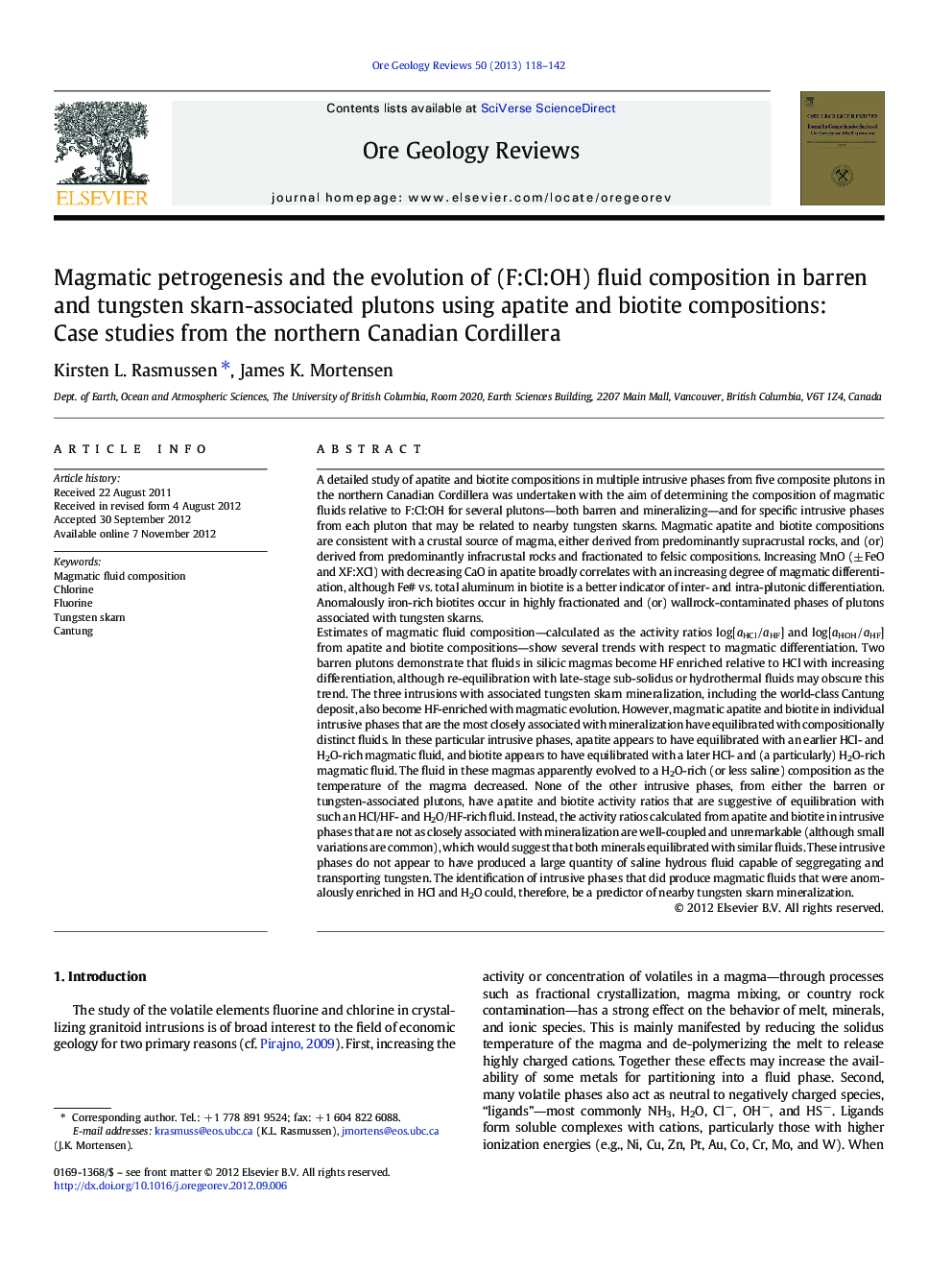| کد مقاله | کد نشریه | سال انتشار | مقاله انگلیسی | نسخه تمام متن |
|---|---|---|---|---|
| 4697583 | 1637253 | 2013 | 25 صفحه PDF | دانلود رایگان |

A detailed study of apatite and biotite compositions in multiple intrusive phases from five composite plutons in the northern Canadian Cordillera was undertaken with the aim of determining the composition of magmatic fluids relative to F:Cl:OH for several plutons―both barren and mineralizing―and for specific intrusive phases from each pluton that may be related to nearby tungsten skarns. Magmatic apatite and biotite compositions are consistent with a crustal source of magma, either derived from predominantly supracrustal rocks, and (or) derived from predominantly infracrustal rocks and fractionated to felsic compositions. Increasing MnO (± FeO and XF:XCl) with decreasing CaO in apatite broadly correlates with an increasing degree of magmatic differentiation, although Fe# vs. total aluminum in biotite is a better indicator of inter- and intra-plutonic differentiation. Anomalously iron-rich biotites occur in highly fractionated and (or) wallrock-contaminated phases of plutons associated with tungsten skarns.Estimates of magmatic fluid composition―calculated as the activity ratios log[aHCl / aHF] and log[aHOH / aHF] from apatite and biotite compositions―show several trends with respect to magmatic differentiation. Two barren plutons demonstrate that fluids in silicic magmas become HF enriched relative to HCl with increasing differentiation, although re-equilibration with late-stage sub-solidus or hydrothermal fluids may obscure this trend. The three intrusions with associated tungsten skarn mineralization, including the world-class Cantung deposit, also become HF-enriched with magmatic evolution. However, magmatic apatite and biotite in individual intrusive phases that are the most closely associated with mineralization have equilibrated with compositionally distinct fluids. In these particular intrusive phases, apatite appears to have equilibrated with an earlier HCl- and H2O-rich magmatic fluid, and biotite appears to have equilibrated with a later HCl- and (a particularly) H2O-rich magmatic fluid. The fluid in these magmas apparently evolved to a H2O-rich (or less saline) composition as the temperature of the magma decreased. None of the other intrusive phases, from either the barren or tungsten-associated plutons, have apatite and biotite activity ratios that are suggestive of equilibration with such an HCl/HF- and H2O/HF-rich fluid. Instead, the activity ratios calculated from apatite and biotite in intrusive phases that are not as closely associated with mineralization are well-coupled and unremarkable (although small variations are common), which would suggest that both minerals equilibrated with similar fluids. These intrusive phases do not appear to have produced a large quantity of saline hydrous fluid capable of seggregating and transporting tungsten. The identification of intrusive phases that did produce magmatic fluids that were anomalously enriched in HCl and H2O could, therefore, be a predictor of nearby tungsten skarn mineralization.
► Detailed study of multi-phase granitic plutons in the northern Canadian Cordillera
► Calculated magmatic fluid compositions from apatite and biotite compositions
► Characterized magmatic fluid compositions of plutons associated with W skarns
► Identified specific intrusive phases that are more prospective for related W skarns
► Presents a method for detecting hidden/buried W skarns
Journal: Ore Geology Reviews - Volume 50, February 2013, Pages 118–142